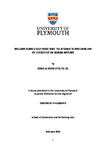William Blake’s Selfhood and the Atomistic Materialism of Lucretius’ De Rerum Natura
| dc.contributor.supervisor | Wild, Min | |
| dc.contributor.author | Schouten de Jel, Joshua | |
| dc.contributor.other | Faculty of Arts, Humanities and Business | en_US |
| dc.date.accessioned | 2021-03-03T14:38:39Z | |
| dc.date.issued | 2021 | |
| dc.identifier | 10267619 | en_US |
| dc.identifier.uri | http://hdl.handle.net/10026.1/16913 | |
| dc.description.abstract |
This thesis demonstrates for the first time the way in which William Blake aligned his idiosyncratic concept of the Selfhood – the lens through which the despiritualised subject beholds the material world – with the atomistic materialism of the Epicurean school as it was transmitted through the first-century BC Roman poet and philosopher Lucretius’ De Rerum Natura. Not only will I argue that Blake was aware of classical atomistic cosmogony and sense-based epistemology, but that he systematically mapped postlapsarian existence onto the philosophical framework of Epicurean cosmogony. As a result, when the subject succumbs to the Selfhood and once the Selfhood manipulates the subject’s ability to observe the external world, a psycho-topography is created which adheres to the fundamental principles of atomistic entropy. Blake calls this the cycle of Eternal Death. By addressing Blake’s philosophical debt to Epicureanism as the principal epistemological system for his characters in a postlapsarian world, I am setting out a threefold re-evaluation of Blake’s work. The first is to clarify the classical stream of Blake’s philosophical heritage through Lucretius’ De Rerum Natura: its rediscovery in early fifteenth-century Europe, its dissemination in sixteenth-century Italy and France, and its translation into English during the seventeenth century. By the latter part of the eighteenth century, Epicurus and Lucretius were being openly adopted in treatises on atheism. This, then, feeds into the second objective, which is to return Blake to his historical moment: a thirty-year period from about 1790 to 1820 which has been described as the second Lucretian moment in England. By the end of the eighteenth century, Blake was able to draw upon an almost three-hundred-year-old European tradition of associating Epicureanism with atheism. As such, this thesis rewrites the stereotype of Blake as a vitriolic recluse, the inventor of an entirely unique personal mythology and, instead, puts forward the argument that Blake’s critical habits were typical of a thriving anti-Epicurean polemic during the revolutionary years. Finally, by reassessing the philosophical permutation and historical context of Blake’s poetry, I am adopting a new exegetical model for understanding the phenomenological parameters and epistemological frameworks of Blake’s postlapsarian schematisation. Whilst I am tracing the Epicurean influence on Blake through the dissemination of Lucretius’ De Rerum Natura in early-modern Europe, this thesis specifically deals with Blake’s adoption of this atomistic legacy as part of the Selfhood. As such, the poetic works upon which I principally focus are those which evidence a formative articulation of the Selfhood in conjunction with the epistemology of the Epicurean school. These, then, provide the philosophical grounding for Blake’s denunciation of Bacon as a follower of ‘Epicurus and Lucretius’ in annotations to Essays Moral, Economical and Political by Francis Bacon (1798). | en_US |
| dc.language.iso | en | |
| dc.publisher | University of Plymouth | |
| dc.subject | William Blake | en_US |
| dc.subject | Lucretius | en_US |
| dc.subject | Selfhood | en_US |
| dc.subject | Atomism | en_US |
| dc.subject | De Rerum Natura | en_US |
| dc.subject | Materialism | en_US |
| dc.subject.classification | PhD | en_US |
| dc.title | William Blake’s Selfhood and the Atomistic Materialism of Lucretius’ De Rerum Natura | en_US |
| dc.type | Thesis | |
| plymouth.version | publishable | en_US |
| dc.identifier.doi | http://dx.doi.org/10.24382/1157 | |
| dc.rights.embargodate | 2022-03-03T14:38:39Z | |
| dc.rights.embargoperiod | 12 months | en_US |
| dc.type.qualification | Doctorate | en_US |
| rioxxterms.version | NA | |
| plymouth.orcid_id | https://orcid.org/0000-0002-0094-4744 | en_US |
Files in this item
This item appears in the following Collection(s)
-
01 Research Theses Main Collection
Research Theses Main


